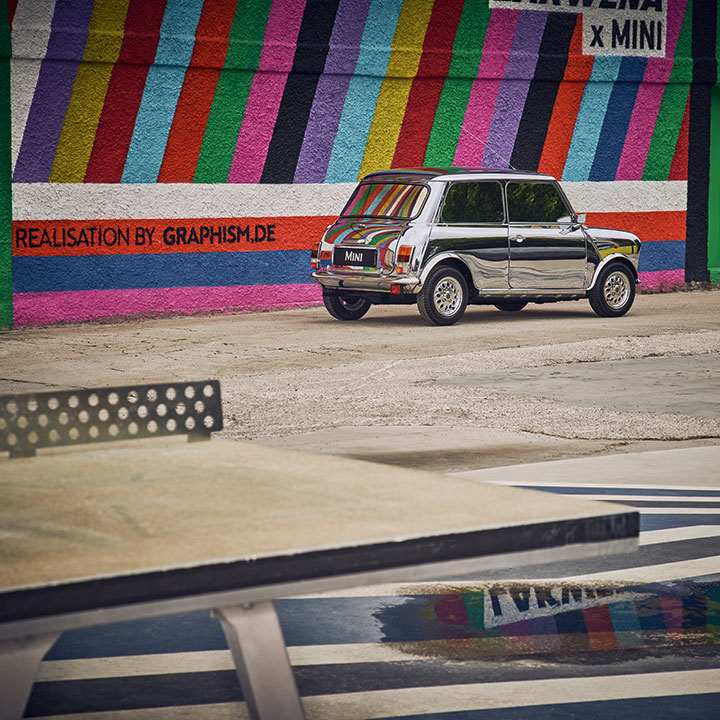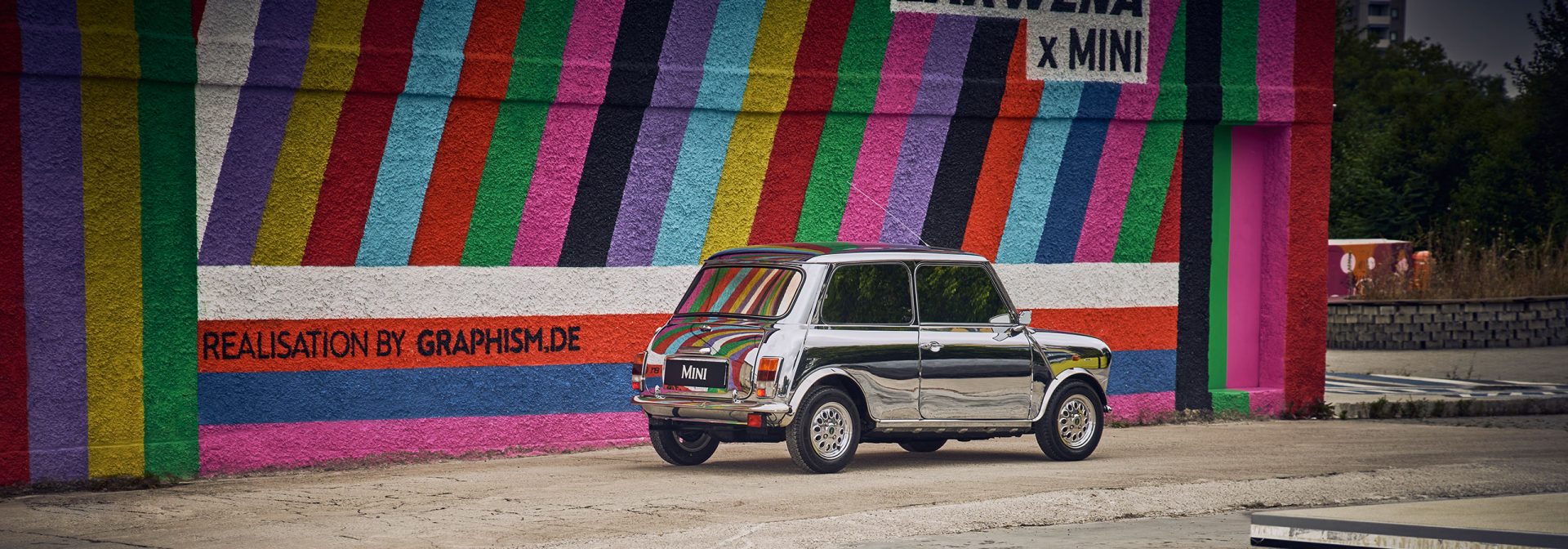Do you want to learn more about the Classic Mini models? Our product catalogue gives you an insight of how the Classic Mini has evolved through more than 40 years of production. Use the filters to search by decades and models.
CLASSIC MINI MODELS.
Everything you need to know in one place.
Discover our historic models.
- All Series
- Classic Mini Hatch
- Wolseley Hornet
- Riley Elf
- Classic Mini Estate
- Classic Mini Van
- Classic Mini Pick-up
- Classic Mini Moke
- Classic Mini Convertible
- All Decades
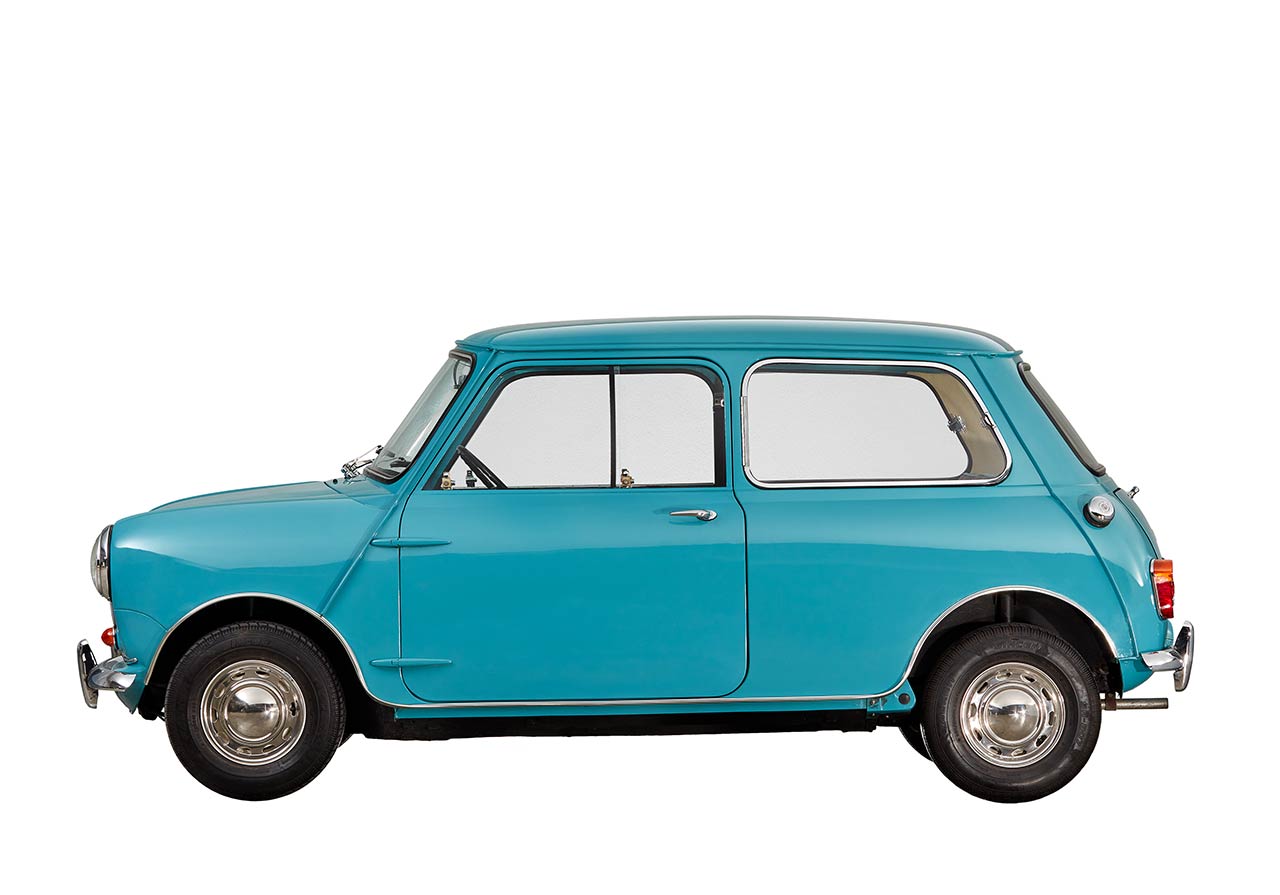

The Austin Seven developed by Alec Issigonis was launched in the public arena in 1959. The "Mini" was fitted with an engine mounted transversely in the front and front-wheel drive and embodied an innovative concept for a small car. It delivered a four-seater saloon with optimum use of space and offered agile and safe performance, making it a pleasure to drive. The Austin Mini 850, as it was called from 1962, was a hit with lots of inventive solutions in the detail. It was quite rightly hailed as a milestone on the way to the modern small car.
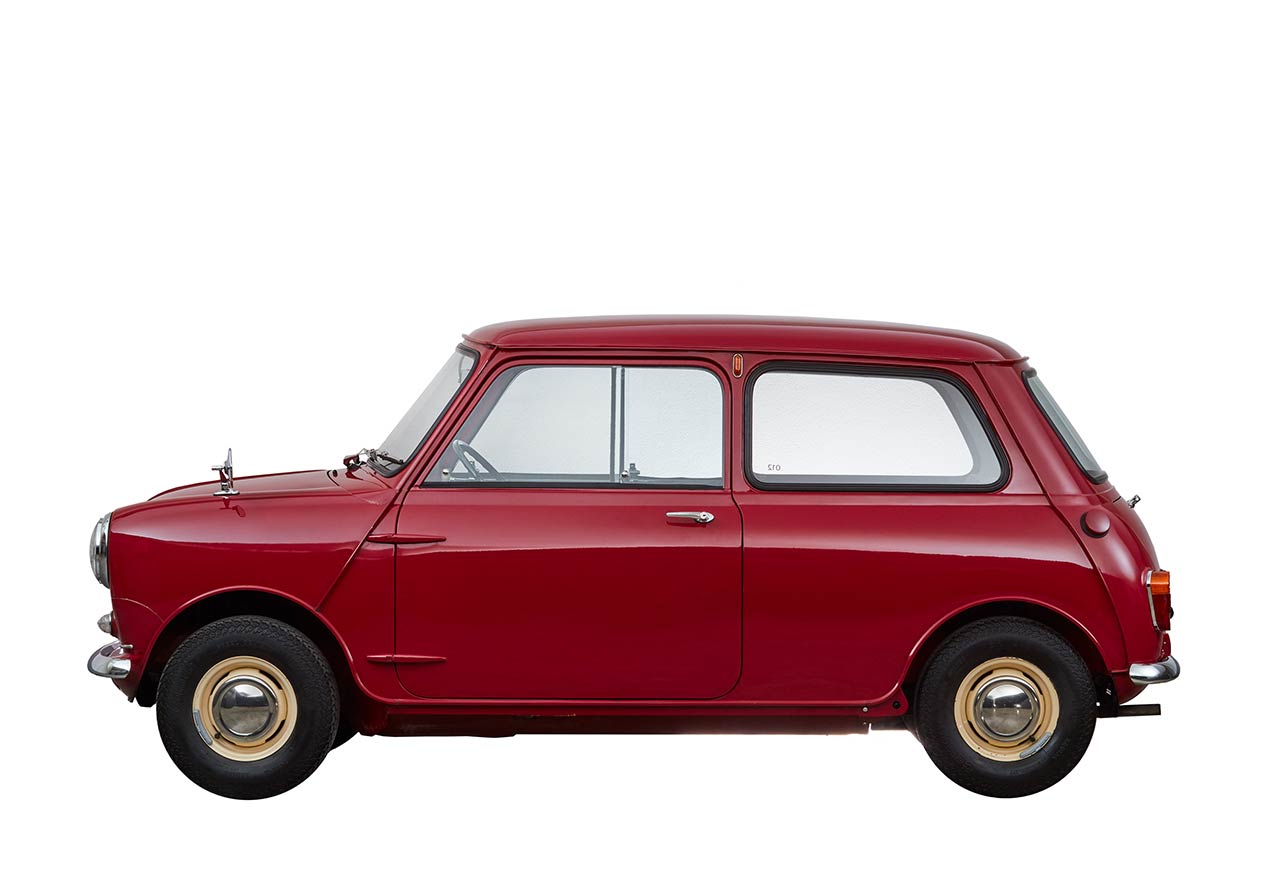

The Morris Mini-Minor developed by Alec Issigonis was launched in the public arena in 1959. The "Mini" was fitted with an engine mounted transversely in the front and front-wheel drive, and embodied an innovative concept for a small car. It delivered a four-seater saloon with optimum use of space and offered agile and safe performance, making it a pleasure to drive. The Morris Mini-Minor was a hit with lots of inventive solutions in the detail. It was quite rightly hailed as a milestone on the way to the modern small car.


The Austin Seven Countryman was launched in the public arena in autumn 1960. This was an estate version with windows of the Austin Seven four-seater small car that had been launched in 1959. The car was fitted with an engine mounted transversely in the front and front-wheel drive and represented a new concept in the construction of small cars. By comparison with the other saloons, built with to the same design in other respects, the length had increased by 25 cm to 3.30 m and the weight had risen by up to 50 kg. Like the Morris Minor Traveller, the rear of the Austin Mini Countryman, as it was officially known from 1962, was designed with wooden trim and the "Woody" Mini was born.


The Morris Mini-Traveller was launched in the public arena in autumn 1960. This was an estate version with windows of the Morris Mini-Minor four-seater small car that had been launched in 1959. The car was fitted with an engine mounted transversely in the front and front-wheel drive and represented a new concept in the construction of small cars. By comparison with the other saloons, built with to the same design in other respects, the length had increased by 25 cm to 3.30 m and the weight had risen by up to 50 kg. Like the Morris Minor Traveller, the rear of the Morris Mini-Traveller was designed with wooden trim and the "Woody" Mini was born.


Five months after the launch of the "Mini" in August 1959, the British Motor Corporation (BMC) had already launched the first bodywork variant on the market with the Minivan in January 1960. Based on a floor assembly extended by 25 cm, the new delivery van offered a generous cargo platform. In order to maximize the utility value, BMC positioned the battery, spare wheel and tank beneath the cargo platform. Designed as a utility vehicle, the van was provided with Spartan equipment. No chrome trims were fitted to the bodywork and the grille characteristic of the van was simply made of stamped sheet metal painted in the colour of the car. Austin and Morris models were only distinguished by their emblem.


Five months after the launch of the "Mini" in August 1959, the British Motor Corporation (BMC) had already launched the first bodywork variant on the market with the Mini-Van in January 1960. Based on a floor assembly extended by 25 cm, the new delivery van offered a generous cargo platform. In order to maximize the utility value, BMC positioned the battery, spare wheel and tank beneath the cargo platform. Designed as a utility vehicle, the van was provided with Spartan equipment. No chrome trims were fitted to the bodywork and the grille characteristic of the van was simply made of stamped sheet metal painted in the colour of the car. Austin and Morris models were only distinguished by their emblem.


The Riley Elf based on the Mini was designed by BMC stylist Dick Burzi as the top of the range. The car with its extended boot and false radiator grille and extensive use of chrome gives an air of elegance. In the interior a full width burr walnut dashboard with glove boxes flanks the central speedometer, oil and water temperature gauges. Leather-cloth seating and thick carpets which also covered the door bins added to the luxury feel, a chrome plated gear lever completed the ambience along with the Riley badge on the horn push to remind you of the heritage. With all the extra features the performance suffered as it used the 848 cc engine, this would be addressed on the Mark II version.


The Wolseley Hornet was designed by BMC stylist Dick Burzi, using the Mini platform. The car with its extended boot and upright radiator grille with its illuminated badge (a feature of Wolseley cars since 1932) plus extensive use of chrome gives an air of refinement. A unique range of colours with contrast roof were available. Central speedometer and auxiliary gauges were surrounded with wood veneer. Leather-cloth seating, thick carpets and chrome gear lever add to the luxury feel. With all the extra features the performance suffered as it used the 848 cc engine. This would be addressed on the Mark II version. The name Hornet had been used on a Wolseley car from 1930 until 1939.
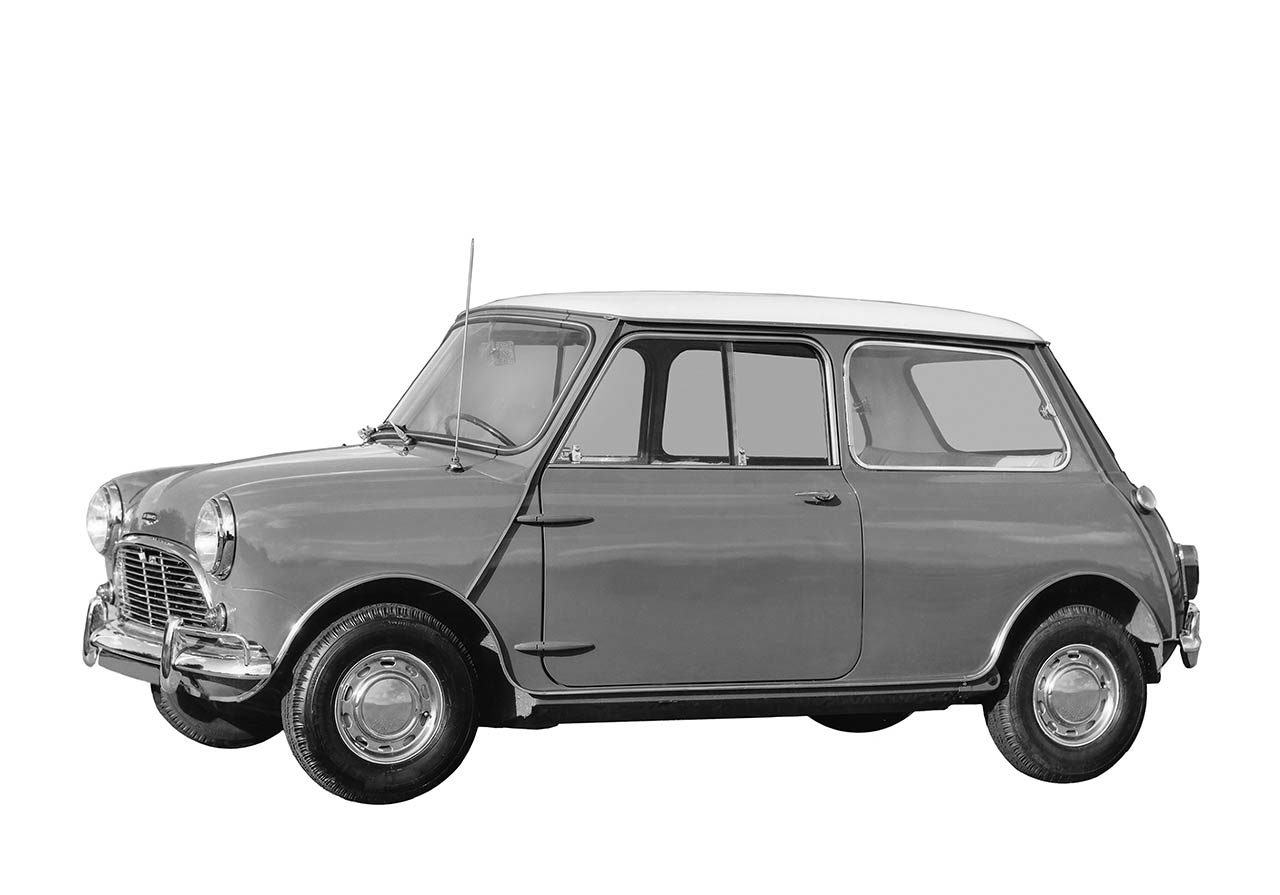

Successful racing-car designer John Cooper was quickly won over by the sporty potential of the Austin Seven. However, the British Motor Corporation (BMC) was sceptical about the idea of a works-tuned Mini-Cooper. As far as they were concerned, the Mini was an affordable and practical small car, but it wasn't a potential sports car. After some intensive persuasion, Cooper triumphed and in 1961 the Austin Seven Cooper was launched on the public stage. It delivered 55 hp at 6000 rpm, had newly developed disc brakes on the front axle and achieved a top speed of 140 km/h. The substantial demand ensured the Austin Mini-Cooper, as it was known from 1962, became a fixed element in the Mini series. Even its first version saw more than 12,000 units being produced by 1964.


Successful racing-car designer John Cooper was quickly won over by the sporty potential of the Morris Mini-Minor. However, the British Motor Corporation (BMC) was sceptical about the idea of a works-tuned Mini-Cooper. As far as they were concerned, the Mini was an affordable and practical small car, but it wasn't a potential sports car. After some intensive persuasion, Cooper triumphed and in 1961 the Morris Mini-Cooper was launched on the public stage. It delivered 55 b.h.p. at 6000 r.p.m., had newly developed disc brakes on the front axle and achieved a top speed of 140 km/h. The substantial demand ensured the Morris Mini-Cooper became a fixed element in the Mini series. Even its first version saw more than 12,000 units being produced by 1964.


After the British Motor Corporation (BMC) had launched a bodywork variant of the Mini for the first time in January 1960 with the Mini-Van, another utility vehicle in the Mini family was launched on the market with the Mini Pick-up in January 1961. The construction of the bodywork was identical with the van up to the B-column and the new pick-up also provided a generous cargo platform. Designed as a utility vehicle, the van was provided with Spartan equipment. No chrome trims were fitted to the bodywork and the grille characteristic of the pick-up was simply made of stamped sheet metal painted in the colour of the car. Austin and Morris models were simply distinguished by their emblem. As with the saloon, BMC marketed the pick-up as Austin and Morris models. The two models were only distinguished by their emblems.


After the British Motor Corporation (BMC) had launched a bodywork variant of the Mini for the first time in January 1960 with the Mini-Van, another utility vehicle in the Mini family was launched on the market with the Mini Pick-up in January 1961. The construction of the bodywork was identical with the van up to the B-column and the new pick-up also provided a generous cargo platform. Designed as a utility vehicle, the van was provided with Spartan equipment. No chrome trims were fitted to the bodywork and the grille characteristic of the pick-up was simply made of stamped sheet metal painted in the colour of the car. Austin and Morris models were simply distinguished by their emblem. As with the saloon, BMC marketed the pick-up as Austin and Morris models. The two models were only distinguished by their emblems.


The Riley Elf Mk II was introduced in January 1963. While retaining all of the luxury details of its predecessor, the car saw numerous improvements to the mechanical specification which would give it better performance. A new larger 998 cc engine with a single SU carburettor increased power by 4 hp and top speed to 123 kph (77 mph). New front brakes with twin leading shoes improved brake efficiency. The boot was now counter balanced which meant safer access to the boot. September 1964 saw the introduction of Hydrolastic suspension. Changes to the interior were limited, but included a combined ignition and starter switch. A Mk II badge on the boot lid identified the model.
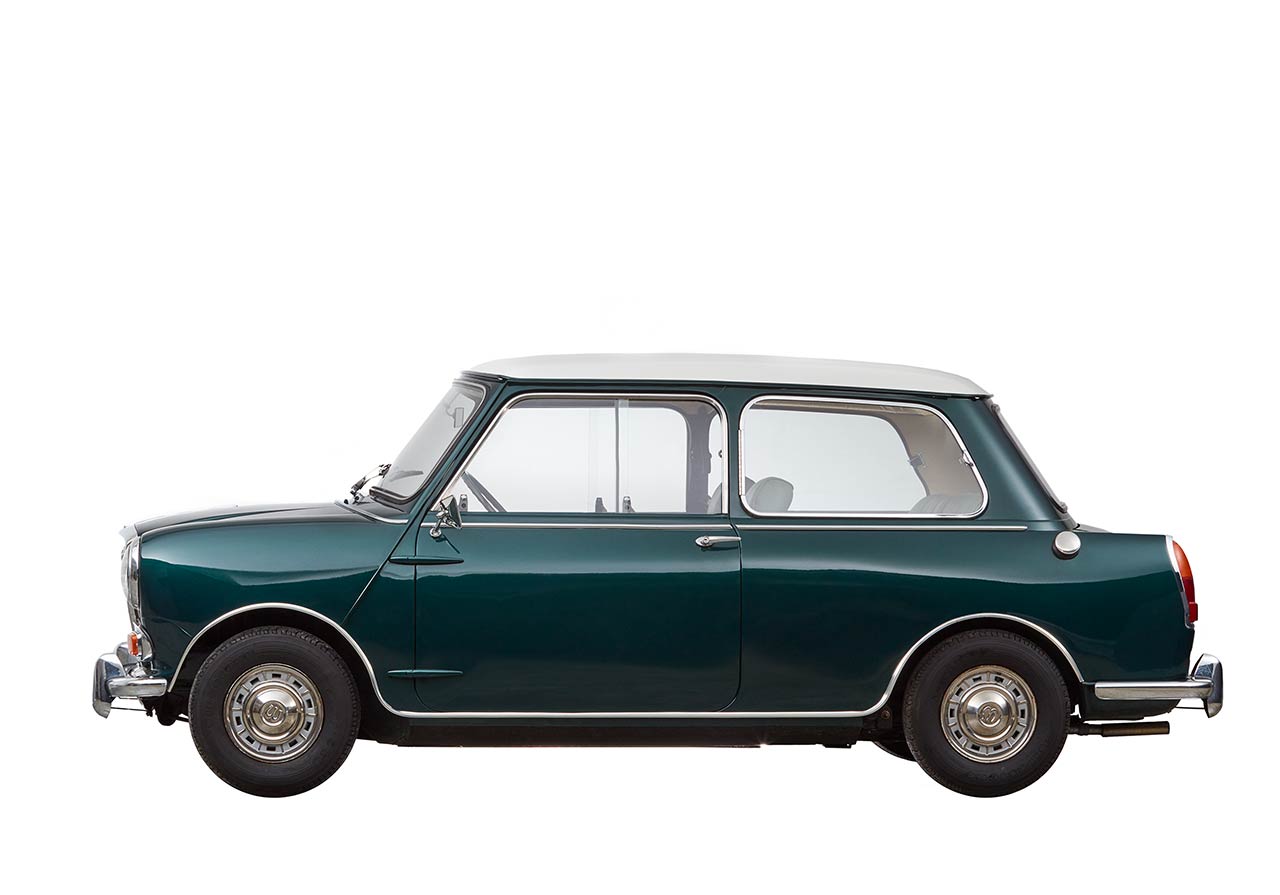

The Wolseley Hornet Mk II was introduced in January 1963. While retaining all of the luxury details of its predecessor, the car saw numerous improvements to the mechanical specification which would give it better performance. A new larger 998 cc engine with a single SU carburettor increased power by 4 bhp and top speed to 123 kph (77 mph). New front brakes with twin leading shoes improved brake efficiency. The boot was now counter balanced which meant safer access to the boot. September 1964 saw the introduction of Hydrolastic suspension. Changes to the interior were limited, but included a combined ignition and starter switch. A Mk II badge on the boot lid identified the model.


Encouraged by the success of the Austin Mini-Cooper, the British Motor Corporation (BMC) launched an even more potent model as an alternative in March 1963. The Austin Mini-Cooper S was developed with a view to motor sport. The engine with 1071 cc delivered an impressive output of 70 b.h.p. at 6200 r.p.m. and produced a performance that was characteristic of a sports car. Engineering innovations like the additional oil cooler, the second petrol tank on the right-hand side and the improved servo-assisted disc brakes were features of the Cooper S and highlighted its sportiness. The special nature of the new Mini-Cooper was only evident on the outside in the perforated wheels and the additional "S" above the type badges.


Encouraged by the success of the Morris Mini-Cooper, the British Motor Corporation (BMC) launched an even more potent model as an alternative in March 1963. The Morris Mini Cooper S was developed with a view to motor sport. The engine with 1071 cc delivered an impressive output of 70 b.h.p. at 6200 r.p.m. and provided a performance that was characteristic of a sports car. Engineering innovations like the additional oil cooler, the second petrol tank on the right-hand side and the improved servo-assisted disc brakes were features of the Cooper S and highlighted its sportiness. The special nature of the new Mini-Cooper was only evident on the outside in the perforated wheels and the additional "S" above the type badges.


The success story of the little "racer" continued with the second version of the Austin Mini-Cooper from January 1964. The 998 cc engine from the Mk II Series of the Riley Elf was installed, although in a modified Cooper trim with a second SU carburettor and higher compression. The engine generated 55 b.h.p. at 5800 r.p.m. The torque was higher and applied earlier, and this meant that the new model had greater traction and was rather faster for the same power.


The success story of the little "racer" continued with the second version of the Morris Mini-Cooper from January 1964. The 998 cc engine from the Mk II Series of the Riley Elf was installed, although in a modified Cooper trim with a second SU carburettor and higher compression. The engine generated 55 b.h.p. at 5800 r.p.m. The torque was higher and applied earlier, and this meant that the new model had greater traction and was rather faster for the same power.


The Austin Mini-Cooper S with 1071 cc capacity had been on sale since March 1963 and it was joined by a further Cooper S model in spring 1964. This had a capacity of 970 cc. The very torquey engine of the 970 model delivered 65 b.h.p. at 6500 r.p.m. The small Cooper S provided an acceleration of 12 seconds to 100 km/h and a top speed of 155 km/h, giving the performance of a sports car. The 1000 production units required for homologation in the 1 litre class for the International Touring Car Championship was already achieved at the start of 1965, together with the twin brother Morris Mini-Cooper S and production then ceased. The low production run means that this is a rarity seldom seen on the roads today.


The Morris Mini-Cooper S with 1071 cc capacity had been on sale since March 1963 and it was joined by a further Cooper S model in spring 1964. This had a capacity of 970 cc. The very torquey engine of the 970 model delivered 65 h.p. at 6500 r.p.m. The small Cooper S provided an acceleration of 12 seconds to 100 km/h and a top speed of 155 km/h, giving the performance of a sports car. The 1000 production units required for homologation in the 1 litre class for the International Touring Car Championship was already achieved at the start of 1965, together with the twin brother Austin Mini-Cooper S and production then ceased. The low production run means that this is a rarity seldom seen on the roads today.


The Austin Mini-Cooper S with 1071 cc capacity had been on sale since March 1963 and it was joined by a further Cooper S model with a capacity of 1275 cc in spring 1964. The 1275 Series model had been developed as the basis of homologation for the 1300 cc class in international rally sport. Acceleration to 100 km/h in less than 11 seconds and a top speed of nearly 160 km/h (with variations depending on the ratio) meant that the most powerful Cooper S achieved the performance of a full-blooded sports car. The car achieved three overall victories in the Monte Carlo Rally in 1964, 1965 and 1967. It became the darling of the public and emerged as the epitome of the Cooper S.


The Morris Mini-Cooper S with 1071 cc capacity had been on sale since March 1963 and it was joined by a further Cooper S model with a capacity of 1275 cc in spring 1964. The 1275 Series model had been developed as the basis of homologation for the 1300 cc class in international rally sport. Acceleration to 100 km/h in less than 11 seconds and a top speed of nearly 160 km/h (with variations depending on the ratio) meant that the most powerful Cooper S achieved the performance of a full-blooded sports car. The car achieved three overall victories in the Monte Carlo Rally in 1964, 1965 and 1967. It became the darling of the public and emerged as the epitome of the Cooper S.


The Mini Moke was launched to the public in August 1964 in both Austin and Morris variants, available in only one colour, Spruce Green. Combined production of both marques was 14,518. UK production ceased in 1968 and transferred to Australia where it had been produced from 1966 to 1981 in various engine sizes. The Moke was sold in the UK as a commercial vehicle with lower rate of tax with only driver's seat, one windscreen wiper and basic vinyl-covered fabric roof at a price of GBP 405. The mechanical parts were all from Mini, the engine detuned to run on low grade fuels and changes to the gearbox restricted the top speed. The name Moke is derived from a type of donkey or pack-horse.


The Mini Moke was launched to the public in August 1964 in both Austin and Morris variants, available in only one colour, Spruce Green. Combined production of both marques was 14,518. UK production ceased in 1968 and transferred to Australia where it had been produced from 1966 to 1981 in various engine sizes. The Moke was sold in the UK as a commercial vehicle with lower rate of tax with only driver's seat, one windscreen wiper and basic vinyl-covered fabric roof at a price of GBP 405. The mechanical parts were all from Mini, the engine detuned to run on low grade fuels and changes to the gearbox restricted the top speed. The name Moke is derived from a type of donkey or pack-horse.


The Riley Elf Mk III is identified by the absence of exterior door hinges and new push button door handles. It was also the first in the Mini range to have wind-up windows. This meant changes to the interior door trim, a reduction in the size of the door pockets and new interior door handles. Swivelling fresh air vents were now fitted into both ends of the full width fascia and a remote gear change lever as used on the Mini-Cooper. Further improvements during its short life were changes to the seats and later a four-speed synchromesh gearbox. All Elf Mk III were fitted with Hydrolastic suspension. By the end of production in August 1969 a total of 9,574 cars had been built.


The Wolseley Hornet Mk III is identified by the absence of exterior door hinges and new push button door handles. It was also the first in the Mini range to have wind-up windows. This meant changes to the interior door trim, a reduction in the size of the door pockets and new interior door handles. Swivelling fresh air vents were now fitted into both ends of the parcel shelf and a remote gear change lever as used on the Mini-Cooper range. Further improvements during its short life were changes to the seats and later a four-speed synchromesh gearbox. All Hornet Mk III were fitted with Hydrolastic suspension. By the end of production in August 1969 a total of 8,504 cars had been built.


In 1966, the British Motor Corporation (BMC) begins manufacturing a small quantity of Mini Moke at its plant in Sydney, Australia. In 1968, the entire production is relocated from England to Australia. The Moke is built under different names there, e.g. BMC Morris Mini Moke, BMC Moke Californian or Leyland Moke and is available in different engine sizes with capacities of 998 cc, 1098 cc and 1275 cc. In 1981, production in Australia comes to an end when the plant is transferred to Peugeot. At this point, production of the Mini Moke has already started up in Portugal. CKD parts are already being sent from Australia to the British Leyland plant Industria Montagem in Setubal from 1980.


In October 1967, the British Motor Corporation (BMC) launched the Mk II Series of the Mini. The Austin Mini 850 Mk II had a new profile with a larger rear window and bigger, angular taillights. The new grille with a wide frame was a striking feature. The engineering of the Mk II Series remained unchanged and there were few modifications during the short production period of only two years. The most important engineering innovation was the introduction of the full synchromesh gearbox for all Mini models in October 1968.


In October 1967, the British Motor Corporation (BMC) launched the Mk II Series of the Mini. The Cooper versions also had a new profile with a larger rear window and the bigger, angular taillights. The new grille with wide trims was a striking feature that was shared by the Austin Mini-Cooper Mk II and its twin brother Morris Mini-Cooper Mk II. The most important engineering innovation was the introduction of the full synchromesh gearbox for all Mini models in October 1968.


In October 1967, the British Motor Corporation (BMC) launched the Mk II Series of the Mini. The Cooper versions also had a new profile with a larger rear window and the bigger, angular taillights. The new grille with wide trims was a striking feature that was shared by the Morris Mini-Cooper Mk II and its twin brother Austin Mini-Cooper Mk II. The most important engineering innovation was the introduction of the full synchromesh gearbox for all Mini models in October 1968.


In October 1967, the British Motor Corporation (BMC) launched the Mk II Series of the Mini. The Cooper S versions had a new profile with a larger rear window and the bigger, angular taillights. The new grille with the wide trims was a striking feature shared by the Austin Mini-Cooper II and its twin brother Morris Mini-Cooper S Mk II. The engineering of the Mk II version of the Cooper S remained unchanged and there were few innovations during the short production period of only two years. The most important innovation was the introduction of the full synchromesh gearbox for all Mini models in October 1968.


In October 1967, the British Motor Corporation (BMC) launched the Mk II Series of the Mini. The Cooper S versions had a new profile with a larger rear window and the larger, angular taillights. The new grille with the wide trims was a striking feature shared by the Morris Mini-Cooper II and its twin brother Austin Mini-Cooper S Mk II. The engineering of the Mk II version of the Cooper S remained unchanged and there were few innovations during the short production period of only two years. The most important innovation was the introduction of the full synchromesh gearbox for all Mini models in October 1968.


In October 1967, the British Motor Corporation (BMC) launched the Mk II series of the Mini. The Morris Mini 850 Mk II had a new profile with a larger rear window and bigger angular taillights. The new grille with the wide frame was a striking feature. The engineering of the Mk II Series remained unchanged and there were only a few modifications during the short production period of only two years. The most important engineering innovation was the full synchromesh gearbox, which was available for all Mini models from October 1968.


In October 1967, the British Motor Corporation (BMC) launched the Mk II series of the Mini. The Austin Mini 1000 Mk II had a new profile with a larger rear window and bigger angular taillights. The new grille with the wide frame was a striking feature. The 998 cc engine installed in the 1000 Series was an old friend at BMC. It had already been fitted in the Riley Elf and Wolseley Hornet models since 1962 and a more powerful version had been a success in the Mini-Cooper since 1964. The Austin Mini 1000 Mk II was the new top model in the standard Mini family and it was only available in the better equipped Super de Luxe version.


In October 1967, the British Motor Corporation (BMC) launched the Mk II series of the Mini. The Morris Mini 1000 Mk II had a new profile with a larger rear window and bigger angular taillights. The new grille with the wide frame was a striking feature. The 998 cc engine installed in the 1000 Series was an old friend at BMC. It had already been fitted in the Riley Elf and Wolseley Hornet models since 1962 and a more powerful version had been a success in the Mini-Cooper since 1964. The Morris Mini 1000 Mk II was the new top model in the standard Mini family and it was only available in the better equipped Super de Luxe version.


In October 1967, the British Motor Corporation (BMC) launched the Mk II Series of the Mini. The Austin Mini Countryman also benefited from the subtle facelift and paraded in the new outfit with a more imposing grille and modifications in the details of the interior (including newly styled steering wheel, improved seats). The previous engine with 848 cc capacity was replaced by the 998 cc engine designed for the Austin Mini 1000 Mk II, generating an output of 39 hp at 5250 rpm. Like the 1000 Series saloon, the Countryman Mk II was only available in the better equipped Super de Luxe version.


In October 1967, the British Motor Corporation (BMC) launched the Mk II Series of the Mini. The Morris Mini Traveller also benefited from the subtle facelift and paraded in the new outfit with a more imposing grille and modifications in the details of the interior (including newly styled steering wheel, improved seats). The previous engine with 848 cc capacity was replaced by the 998 cc engine designed for the Morris Mini 1000 Mk II, generating an output of 39 bhp at 5250 rpm. Like the 1000 Series Saloon, the Traveller Mk II was only available in the better equipped Super de Luxe version.


The value-for-money and practical Minivan was a popular bodywork version of the Mini. Based on a floor assembly extended by 25 cm, the small "packhorse" offered generous cargo space. Launched on the market in January 1960, the van was successful in large and small businesses alike. Designed as a utility vehicle, the van was provided with Spartan equipment. No chrome trims were fitted to the bodywork and the grille characteristic of the van was simply made of stamped sheet metal painted in the colour of the car. From October 1967, BMC also supplied the more powerful engine with 998 cc displacement in the van as an option. It generated 39 b.h.p. at 5250 rpm and travelled at a top speed of 121 km/h.


Alongside the van, the pick-up was the second utility vehicle in the product range of the Mini. The construction of the bodywork was identical with the van up to the B-column and the new pick-up also provided a generous cargo platform. Designed as a utility vehicle, the pick-up was provided with Spartan equipment. No chrome trims were fitted to the bodywork and the grille characteristic of the pick-up was simply made of stamped sheet metal painted in the colour of the car. As with the saloon, BMC marketed the pick-up as Austin and Morris models, distinguished only by their emblems. From October 1967, BMC also supplied the more powerful engine with 998 cc displacement in the pick-up as an option. It generated 39 hp at 5250 rpm and travelled at a top speed of 121 km/h.


The value-for-money and practical Minivan was a popular bodywork version of the Mini. Based on a floor assembly extended by 25 cm, the small "packhorse" offered generous cargo space. Launched on the market in January 1960, the van was successful in large and small businesses alike. Designed as a utility vehicle, the van was provided with Spartan equipment. No chrome trims were fitted to the bodywork and the grille characteristic of the van was simply made of stamped sheet metal painted in the colour of the car. From October 1967, BMC also supplied the more powerful engine with 998 cc displacement in the van as an option. It generated 39 hp at 5250 rpm and travelled at a top speed of 121 km/h.


Alongside the van, the pick-up was the second utility vehicle in the product range of the Mini. The construction of the bodywork was identical with the van up to the B-column and the new pick-up also provided a generous cargo platform. Designed as a utility vehicle, the pick-up was provided with Spartan equipment. No chrome trims were fitted to the bodywork and the grille characteristic of the pick-up was simply made of stamped sheet metal painted in the colour of the car. As with the saloon, BMC marketed the pick-up as Austin and Morris models, distinguished only by their emblems. From October 1967, BMC also supplied the more powerful engine with 998 cc displacement in the pick-up as an option. It generated 39 h.p. at 5250 rpm and travelled at a top speed of 121 km/h.


In October 1969, British Leyland (BL) launched a new version of the Mini on the market, which marked the end of the Mk II Series. Like its less powerful brother Mini 850, the Mini 1000 had a new visual appearance with interior door hinges, wind-up windows and the brand new Mini emblem, an outfit that was to shape the profile of the Mini until the end of the 1980s. The 1000 Series model differed from the basic model with better equipment and more agile performance.
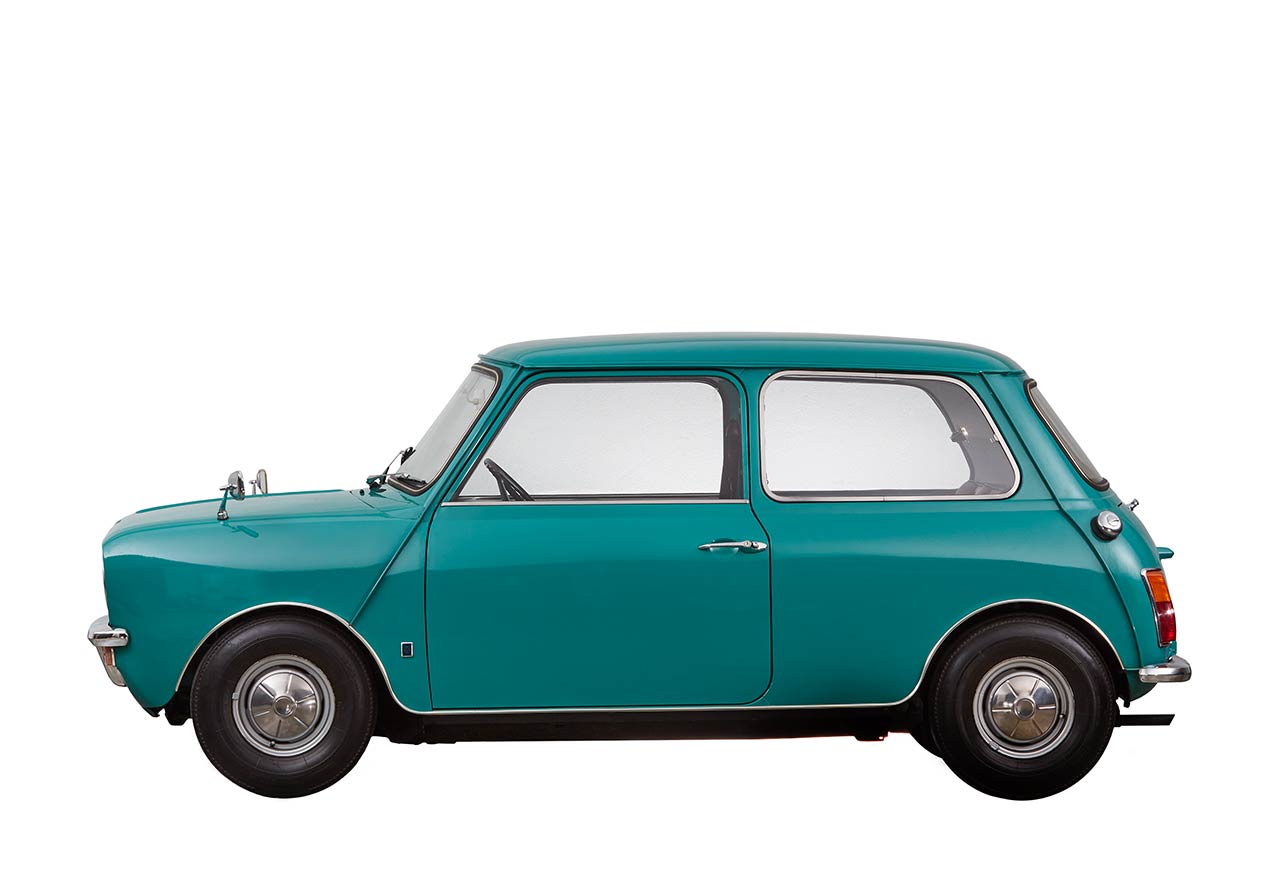

In October 1969, British Leyland (BL) launched the new Mini Clubman. It ranked above the previous models in the hierarchy and was available as a saloon and estate. The estate completely replaced the existing estate versions Austin Mini Countryman and Morris Mini-Traveller. The Clubman was the result of the work by chief stylist Roy Haynes, who endeavoured to turn the Mini into a more modern small car for the 1970s. The front end had been extensively reworked and was intended to make the Clubman appear both safer and more mature. However, the motoring public did not fully accept the Clubman and sales figures lagged behind the optimistic expectations.
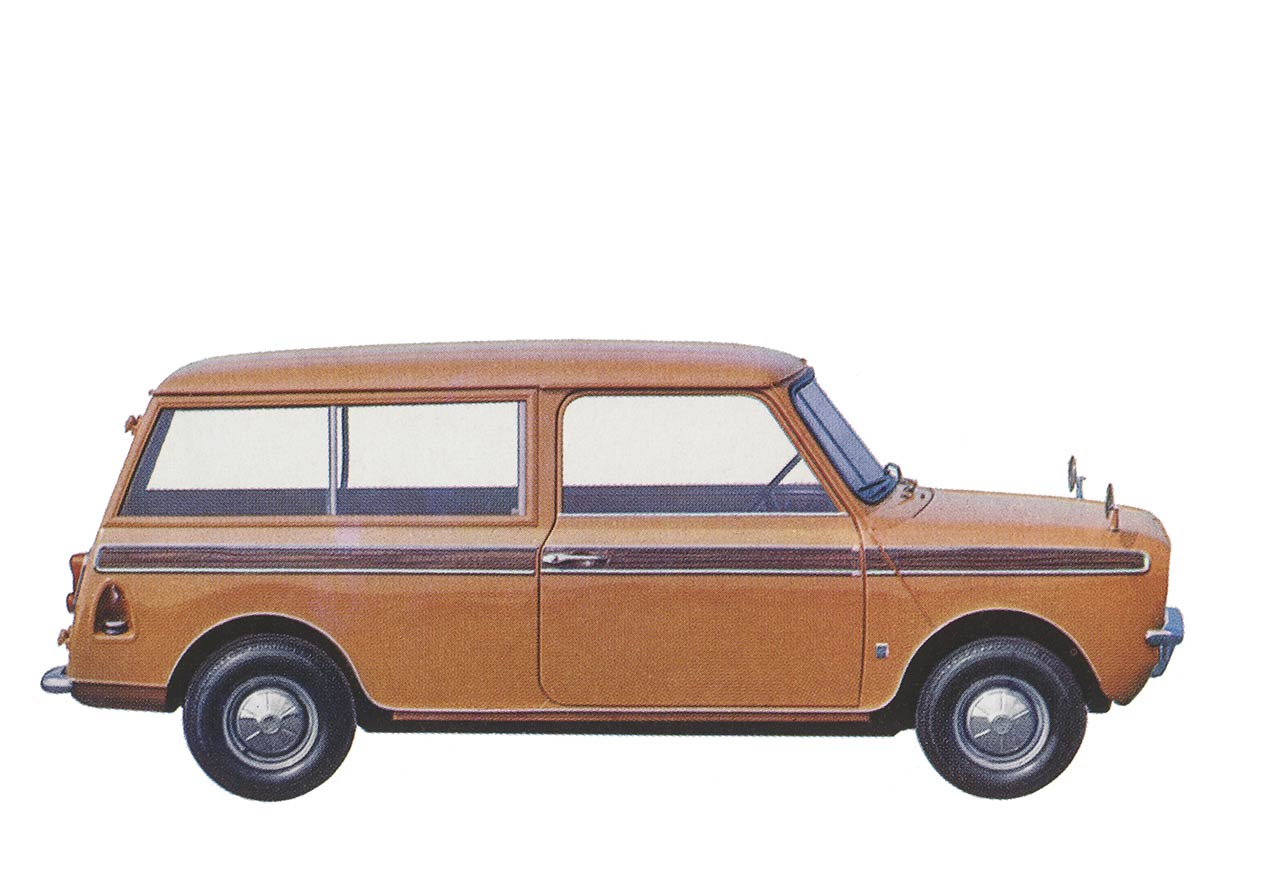

In October 1969, British Leyland (BL) launched the new Mini Clubman Estate. It replaced the discontinued Austin Mini Countryman and Morris Mini-Traveller Estate versions. The previous option of ordering the Mini Estates with or without the wood trim (known as "Woody") was no longer available with the estate. Instead it had a trim made of imitation wood and framed in chrome running along the entire length of the car. The Clubman Series reflected the work of chief stylist Roy Haynes, who endeavoured to turn the Mini into a more modern small car for the 1970s. The front end had been extensively reworked and was intended to make the new Clubman appear safer and more mature.


In October 1969, British Leyland (BL) launched the new Clubman Series. It reflected the work of chief stylist Roy Haynes, who endeavoured to turn the Mini into a more modern small car for the 1970s. The Mini 1275 GT was the new top model in this series and replaced the Austin/Morris Mini-Cooper Mk II, which had been discontinued in autumn 1969. It was fitted with components from the Mini-Cooper S and was intended to continue the sporting tradition of the Mini. The sporty Clubman Mini never entirely succeeded in winning over the enthusiastic Cooper fans, since it lacked the charisma and performance of the popular Cooper S models.


The appealing, simple form of the "original Mini" from 1959 continued to live on in the design of the new basic model Mini 850. Equipment was restricted to essentials, the familiar 848 cc Series-A engine generating 34 b.h.p. at 5500 rpm enabled the successful small car to achieve respectable performances. The new version with the internal designation ADO 20 was launched in October 1969 and the exterior was distinguished by door hinges now positioned in the interior and new wind-up windows. When production of the 850 Series model came to an end in August 1980, the 848 cc power unit was finally discontinued in the Mini saloon.


The Mini-Van launched in January 1960 was a popular bodywork version of the Mini. Based on a floor assembly extended by 25 cm, the small "packhorse" offered generous cargo space. Designed as a utility vehicle, the van was provided with Spartan equipment. No chrome trims were fitted to the bodywork and the grille characteristic of the van was simply made of stamped sheet metal painted in the colour of the car. From October 1969, British Leyland (BL) marketed all Minis under the new Group brand Mini. The otherwise unchanged van now bore the type designation Mini Van 850 or Mini Van 1000, depending on the engine fitted. The Mini emblem positioned on the bonnet underlined the new brand identity.


The Mini-Van launched in January 1960 was a popular bodywork version of the Mini. Based on a floor assembly extended by 25 cm, the small "packhorse" offered generous cargo space. Designed as a utility vehicle, the van was provided with Spartan equipment. No chrome trims were fitted to the bodywork and the grille characteristic of the van was simply made of stamped sheet metal painted in the colour of the car. From October 1969, British Leyland (BL) marketed all Minis under the new Group brand Mini. The otherwise unchanged van now bore the type designation Mini Van 850 or Mini Van 1000, depending on the engine fitted. The Mini emblem positioned on the bonnet underlined the new brand identity.


From October 1969, British Leyland (BL) marketed all Minis under the new Group brand Mini. The new brand identity was highlighted by a new brand identity, which adorned the bonnet of the public's darling for the first time. The otherwise unchanged pick-up bore the type designation Mini Pick-up 850 or Mini Pick-up 1000, depending on the engine fitted. Like the van, it was based on a floor assembly extended by 25 cm compared with the saloon and provided a generous cargo platform. Designed as a utility vehicle, the pick-up was provided with spartan equipment. No chrome trims were fitted to the bodywork and the grille characteristic of the pick-up was simply made of stamped sheet metal painted in the colour of the car.


From October 1969, British Leyland (BL) marketed all Minis under the new Group brand Mini. The new brand identity was highlighted by a new brand identity, which adorned the bonnet of the public's darling for the first time. The otherwise unchanged pick-up bore the type designation Mini Pick-up 850 or Mini Pick-up 1000, depending on the engine fitted. Like the van, it was based on a floor assembly extended by 25 cm compared with the saloon and provided a generous cargo platform. Designed as a utility vehicle, the pick-up was provided with spartan equipment. No chrome trims were fitted to the bodywork and the grille characteristic of the pick-up was simply made of stamped sheet metal painted in the colour of the car.


For the new version of the Mini produced from autumn 1969 (internal designation ADO 20), many changes were implemented inside and outside the vehicle. The external door hinges disappeared, as did the sliding windows. All Minis had the same grille and the same Mini emblem on the bonnet. The new Mini Cooper S Mk III shared all these changes with its less powerful brothers and could only be distinguished by its perforated wheel rims, the Mini Cooper S badge on the boot lid, and the right-hand filler neck for the second tank. Even if the little "racer" had lost much of its original exclusivity, the performance and driving fun still attracted an enthusiastic following.


In October 1975, a slightly revised version of the Mini Clubman was launched. The capacity of the familiar 998 cc engine was increased to 1098 cc and the engine now delivered 45 hp at 5250 rpm. No other changes were forthcoming until British Leyland (BL) fitted a new grille with a different logo in May 1976, a heated rear window, radial tyres and bigger pedals. Despite continued improvements in equipment, the Mini Clubman never achieved the desired sales success and when demand continued to fall at the end of the 1970s, production of the Mini Clubman ceased in the summer of 1980.


In October 1969, British Leyland (BL) launched the new Mini Clubman Estate. It replaced the discontinued Countryman/Traveller Estate versions. In October 1975, a slightly revised version of the estate was launched. The capacity of the 998 cc engine had been increased to 1098 cc and the engine now delivered 45 hp at 5250 r.p.m. No other changes were forthcoming until May 1976 when British Leyland (BL) fitted a new grille with a different logo, radial tyres and bigger pedals. The Mini Clubman never entirely captured the hearts of the motoring public - neither as a saloon nor as an estate - and therefore remained a short episode in the long history of the Mini.


The British Leyland (BL) Group suffered severe financial setbacks and in 1980 the group discontinued production of the Mini Clubman Series. The one exception was the Mini Clubman Estate version. Production of this model continued until February 1982, although under the designation Mini 1000 HL Estate from October 1980. The car was powered by the "A-plus" engine fitted in the new Austin Mini Metro. This was a further development of the familiar Series A engine, which had been installed for many years in the Mini. February 1982 saw the end of production of the Mini Estate versions, whose most famous representative had been the "Woody".


When production of the proven 848 cc engine finally came to an end in August 1980 British Leyland (BL) installed the "A-plus" engine with 998 cc displacement and an output of 39 hp at 4750 rpm, as used in the Mini Metro. The gearbox and other components from the interior (e.g. gear lever, window-lift handles) were also taken over from the Mini Metro. The basic model now bore the designation Mini City and – like its predecessor Mini 850 City – could be identified by the black bumpers and the "City" badge on the boot and front wings. The sober simplicity familiar from the earlier years of the Mini continued to prevail in the interior.


In October 1980, the Mini 1000 HL replaced the former top model Mini 1000 Super. The car was now powered by the "A-plus" engine with 998 cc displacement and an output of 39 hp at 4750 rpm. This engine was also being fitted in the new Mini Metro. Already in June 1980, the comprehensive silencing package called "Quiet Mini" was introduced in all Mini Hatch models, making the vehicles much quieter. Moreover, the 1000 HL took over the two-part instrument cluster fitted directly behind the steering wheel from the discontinued Mini Clubman and the Clubman's hub caps. The new Austin-Morris emblem was positioned on the grille.


CKD parts are already being sent from Australia to the British Leyland plant Industria Montagem (IMA) in Setubal from 1980. However, production of the Mini Moke in Portugal only starts up properly in 1983. It is transferred to Vendas Novas in 1984 and is closed down completely by the new owner, Rover Group, in 1989. In 1990, the Italian motorcycle manufacturer Cagiva, Bologna, buys up the brand and establishes a subsidiary company named Moke Automobili SpA, which re-starts production of the Moke in Portugal. In 1993, Cagiva decides to discontinue production in Portugal and transfers the entire production facilities to its own motorcycle plant in Italy with the aim of continuing production there at the beginning of 1995. However, this fails to become a reality. The era of the Mini Moke finally comes to an end in 1993.


The Mini Mayfair was launched in September 1982. It replaced the former top model Mini 1000 HLE. The Mayfair was much better equipped than the basic model and virtually offered a luxury interior. The car was powered by the "A-Plus" engine revised in April 1982, with 998 cc displacement and an output of 40 hp at 5000 rpm. In October 1984, the Mini received 12-inch wheel rims and one year later, the instrument cluster positioned in the centre that was characteristic of the Mini was replaced by a two-part cluster positioned directly in the driver's field of view. In May 1992, the Mini Mayfair with 1.3 litre displacement replaced the previous model.


In April 1982, a further revision was carried out - the Mini 1000 HLE was introduced and replaced the former top model Mini 1000 HL. The 1000 Series engine was given a higher compression (10.3:1) and a longer drive ratio (2.95:1) with the aim of improving petrol consumption. The engine now generated 40 hp at 5000 rpm. The price for the revised version with matt-black bumpers: 3,363 punds. In September 1982, the Mini 1000 HLE was discontinued and replaced by the Mini Mayfair.


In April 1982, the Mini City E was introduced and replaced the former basic model Mini City. With the aim of improving petrol consumption, the engine was given a higher compression, a longer drive ratio and now generated 40 hp at 5000 rpm. The side trims were eliminated, only the "City" badge on the lower edge of the doors and on the boot still identified the basic model. In October 1984, the Mini received 12-inch wheel rims and one year later, the instrument cluster positioned in the centre that was characteristic of the Mini was replaced by a two-part cluster positioned directly in the driver's field of view. The Mini City E came to an end in August 1988, and the basic model was now called Mini City again.


In August 1988, the "E" in the type designation of the basic model of the Mini Limousine was removed, this was now once again called Mini City. The "A-plus" engine with 998 cc displacement, which was used in the Metro, served as the engine and had an output of 42 hp at 5250 rpm. Externally, the “City” badge on the rear quarter-panels indicated the basic model. In addition, front-seat head restraints, a three-spoke steering wheel and rear seat belts were fitted as standard. From June 1989, a catalytic converter was available as an optional extra for the first time. In May 1992, the Mini Sprite with 1.3 cc displacement replaced the former Mini City basic model.
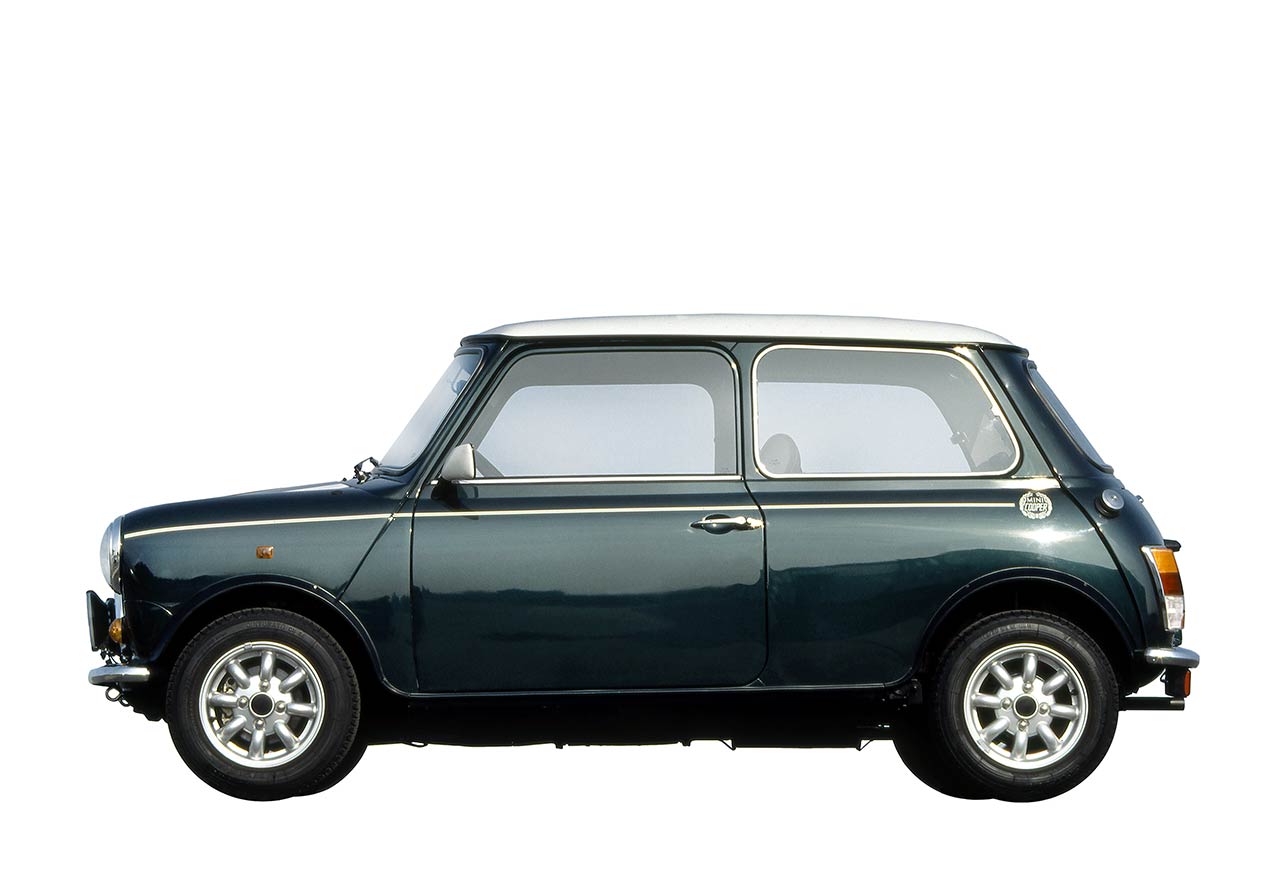

The Mini-Cooper was again available in July 1990 now with a 1275 cc engine as a special limited edition with some unique features. The most outstanding being bonnet stripes with a facsimile of John Cooper's signature and two driving lamps as standard. It featured black leather seats, steering wheel and carpets red in colour. 1,000 were built for the UK and 650 for Japan. September 1990 saw a mainstream version with a reduced specification. Now it had cloth seats and all interior fittings were in black and no sunroof. It had no bonnet stripes or driving lights. Production volume of the mainstream car amounted to 19,899, nearly 50 percent of Mini production during this period.
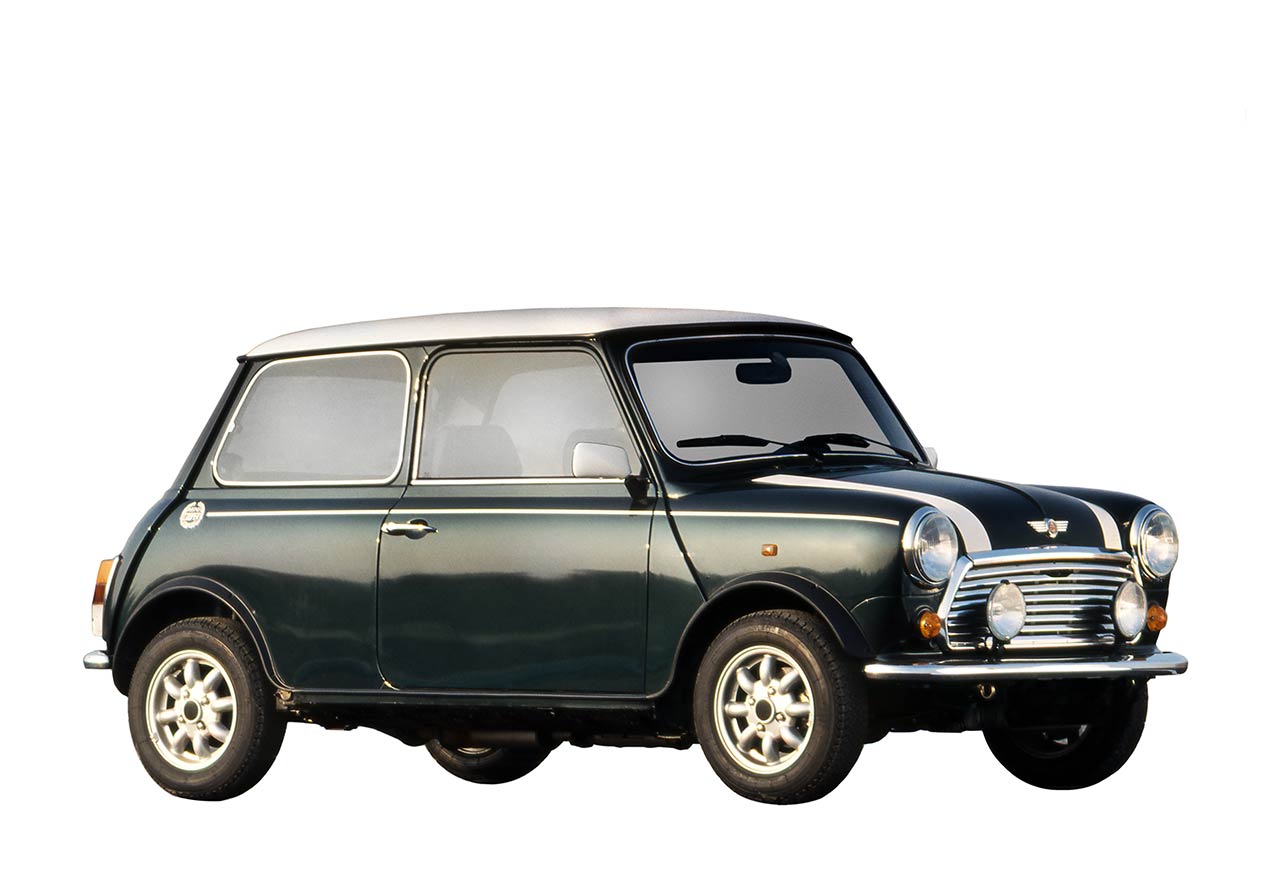

October 1991 saw the introduction of a 1275 cc single point fuel injection engine with three-way catalyst, to comply with new emission regulations. To accommodate the engine management box in the engine compartment, the screen washer bottle moved into the boot. The boot lid gained a copy of the bonnet badge plus a 1.3i badge, the number plate light was now painted black. Bonnet stripes minus the signature and two driving lights and mirrors colour-coded to the roof completed the appearance. Improved black half leather and fabric seats with red piping complemented the red carpet. The colour range was now red, green and black, with white roof, plus white, grey and quicksilver with black roof.


In May 1992 the Mini Sprite became the entry level to the range, replacing the Mini City. It used the 1275 cc engine which was now the only engine specified for the Mini. The new specification included chrome bumpers and a chrome Mini badge on the boot and 'Sprite' graphics on the rear panels. Exterior and interior door handles and window winders were now in black, as was the driver's door mirror. From August 1994 the Sprite was fitted with single point fuel injection, giving an increase in power of three hp over the carburettor model. In August 1996 the Mini Sprite was deleted, to be replaced by the Mini 1.3i with multi-point fuel injection.


From May 1992 the Mini Mayfair was only available with a 1275 cc carburettor engine, as the 998 cc engine used since its introduction in 1982 had been discontinued. It now had a chrome grille and revised chrome badges. The door mirrors were also colour-coded to the body colour. Further changes took place when single point fuel injection was introduced into the Mini Mayfair in August 1994, nearly three years after it was fitted to the Mini Cooper, giving an increase in power of three hp over the carburettor model. In August 1996 the Mayfair was deleted from the range. It would later be replaced by the Mini 1.3i.


The official Mini Cabriolet built at Longbridge went on sale in July 1993. It used the Cooper 1.3i single point injection engine giving 63 bhp and a top speed of 148 km/h (92 mph). Available in only two colours and a unique body kit, the cabriolet set apart from the other models. The interior was fitted with burr walnut dashboard, door capping and gear lever knob. Special front seats, in Chevron trim (later Granite) also used on the door pads held the occupants in place, the colour coded seat belts and black cut pile carpet added to the ambience. The five spoke alloy wheels, exclusive to the model, completed the appearance.
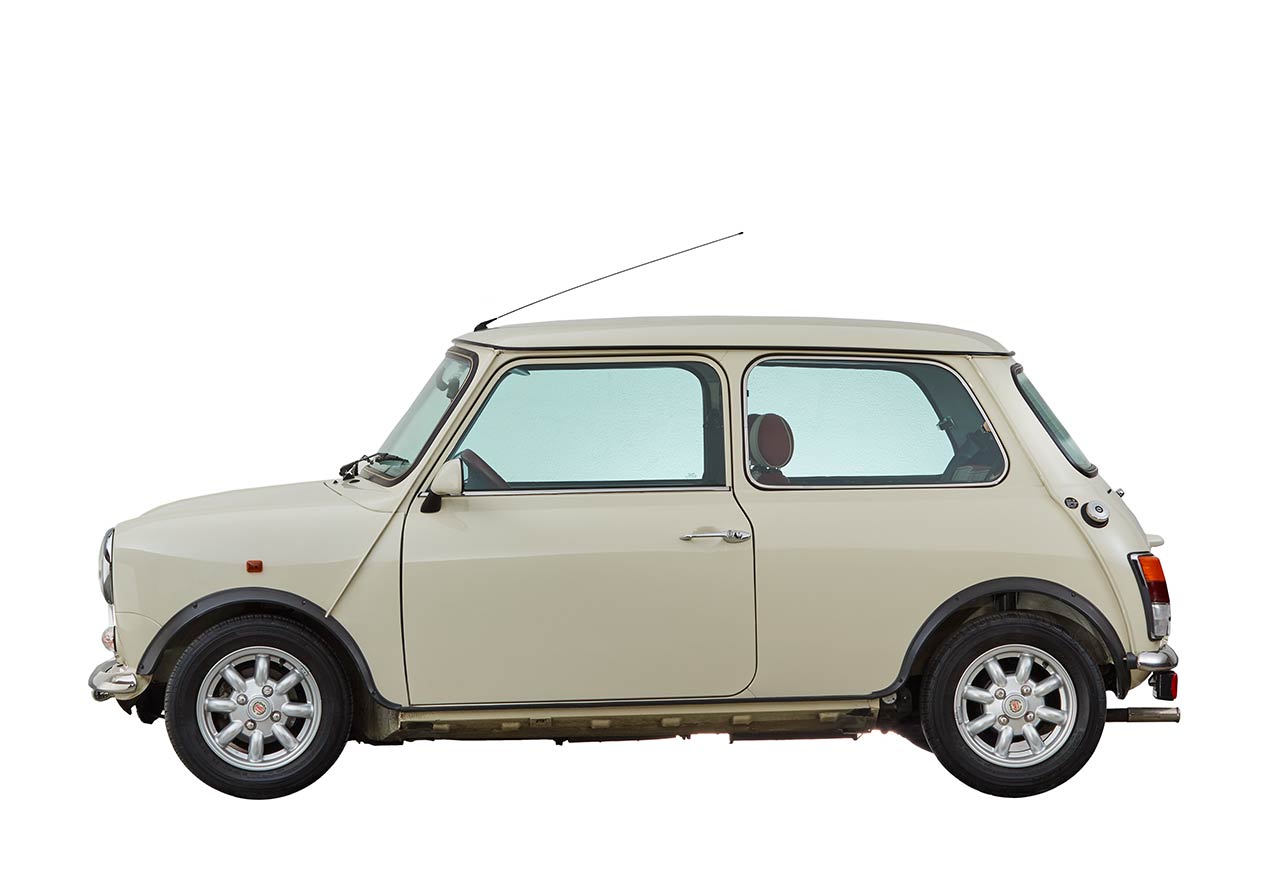

A new multi-point fuel injection system was introduced to keep Mini 1.3i compliant with new EC regulations in October 1996. It engine and pricing both now shared with the Cooper version. Drive-by noise directives were helped by moving the radiator to the front of the car and fitting a higher final drive gear ratio. Safety improvements included a driver's airbag, seat belt pre-tensioners and side impact protection beams. Interior changes included a wood fascia and Balmoral Tweed check trim. April 2000 saw the"Mini Classic edition" with four final variants: the Seven, Cooper, Cooper Sport and the Knightbridge. In October 2000 the very last Mini rolled off the production line.
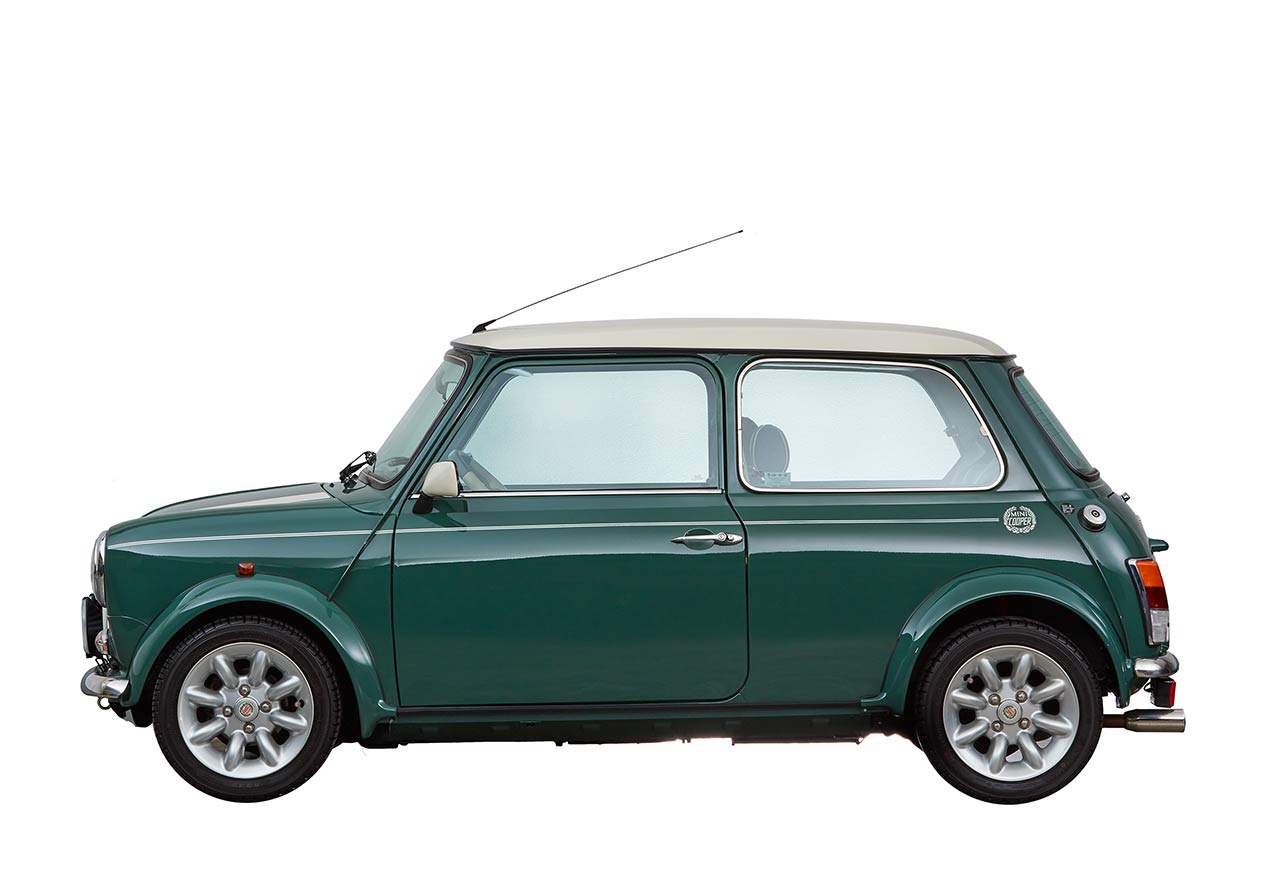

A new multi-point fuel injection system was introduced to keep the Mini Cooper compliant with new EC regulations. Drive-by noise directives were helped by moving the radiator to the front of the car and fitting a higher final drive gear ratio. Safety improvements included a driver's airbag, seat belt pre-tensioners and side impact protection beams. Interior changes included a full-width wood fascia and new trim. Top of the options list was a "Sports Pack" which included 13 inch wheels. In April 2000 with the announcement of the run out, there were two models, Cooper and Cooper Sport (featuring the Sports Pack). A red and silver Cooper Sport was the last classic Mini produced on 4 October 2000.
